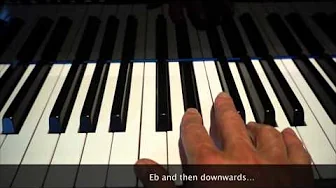The Beatles Blackbird - Piano Tutorial Pt 1

Details
| Title | The Beatles Blackbird - Piano Tutorial Pt 1 |
| Author | Raphael Antonio Nazario (Raf) |
| Duration | 6:44 |
| File Format | MP3 / MP4 |
| Original URL | https://youtube.com/watch?v=AmqSjOFVsQI |
Description
"Blackbird" is a Beatles song from double-disc album, "The Beatles"(also known as The White Album). Blackbird was written by Paul McCartney, who was inspired to write this while in Scotland as a reaction to racial tensions escalating in America in the spring of 1968.
This is a tutorial is not intended to copy the original recording note for note, rather to walk the viewer through the harmonic construction and techniques for playing the song on the piano.
THE SONG, PART 1:
It's in the key of G.
So let’s start simple…imagine the intervals to be in thirds… I third apart.
We are doing parallel thirds… and we have a G chord outlined.
Then it leaps up an octave to the next G chord (represented by G and B)
It repeats, and the, at the “take these lonely wings…” it goes
from the I (G), to the IV (C).
But the C chord is only partially represented… C and E only (G omitted)
And it's moving up from C, as a walk-up…
C & E
C# & G
D & F#
D# & A
E & G
The chord progression works beautifully in the harmonic sense… Quite brilliant.
We have a C chord (C & E);
And the next chord, C# & G is for all intents an purposes an A7 —without the A or the E.
And then we go down a fifth, to the D chord (but our fingers move up to the D & F#)
B7 is the next chord—no B and no F#…
SIDE NOTE: In jazz, these are sometimes known “Shell Chords”, chords without all the notes in it but you can still hear the main elements. (A bit like seeing the phrase “can u plz txt me?” and you know instantly what is being conveyed.)
So we’re going from C, to A (A7), to D, to B (B7) down to E.
In Harmonic terms: we go from C… down a 3rd (A7), down a 5th (D), down a 3rd (B7), down another 5th (Em)
Then Eb…
Then the melody line moves downward…
Chords:
D, then A7, then C, then C minor (C & Eb)…
G (B & D)
A (A & C#)
Am (A & C)
Which becomes the top end of D7
(Holding the C and walking the A down to G and then F# creates the suspension and resolution, should you want it all tied up neatly.)
And then back to G.
In the original, right after "Waiting for that moment to Arise…"
we hear a C chord (C & E),
a G chord (B & D),
An A chord (A & C#),
D7 chord ( A & C)
and then back to G ( G & B)
Later variation, it walks up and down for that killer phrase…
G & B
A & C
B & D
C & E
B & D
Bb & Db
A & C (over A)
A & C (over D)
Back to G.
________
For instructional purposes only. No copyright infringement intended. Please subscribe for more songs and if you have any requests I'm happy to consider them